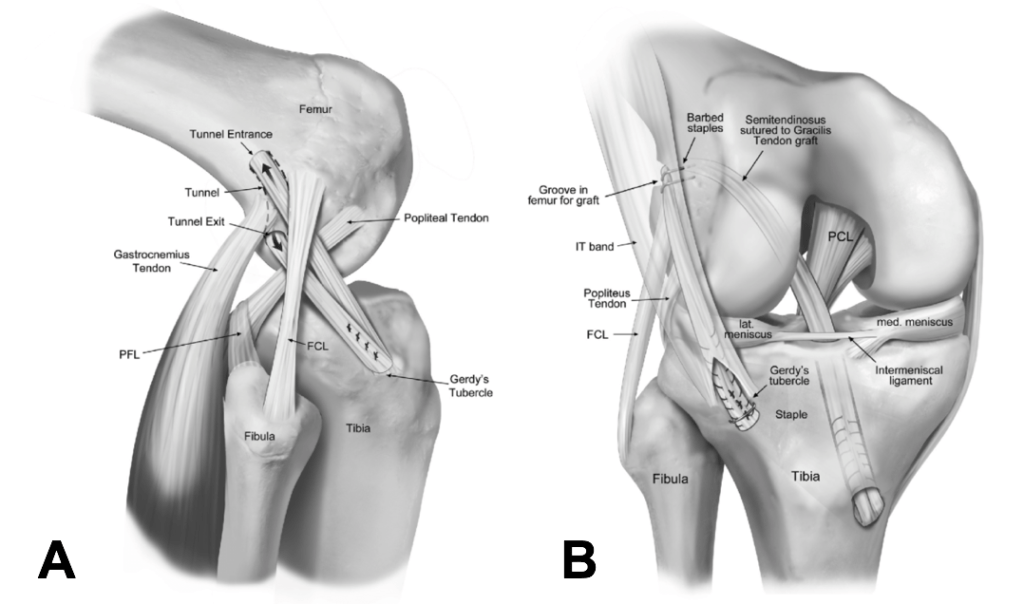ACL injuries impact both athletes and non-athletes in the United States. The ACL is a crucial ligament in the knee, which provides stability and helps support actions like pivoting, jumping, and sudden change in direction. Unfortunately, due to its poor healing potential, ACL Reconstruction or surgery is often required to restore full knee function after a tear.

Image credit: jeremyburnhammd.com
Understanding the ACL reconstruction process, the role of a specialist ACL surgeon and the advancements in surgical technique can help you to make an informed decision on your treatment.
The ACL’s Role and Why Reconstruction is often necessary
The ACL connects the femur (thighbone) and tibia, (shinbone). It is crucial in stabilizing the joint of the knee when it moves. When the ACL is torn, whether caused by a sudden twist or falling awkwardly, or during high-impact activities, the knee’s stability is severely impaired. ACL tears can result in discomfort and swelling. They could also cause you feel that your knee “gives out” during your activity.
Minor injuries to other ligaments may occasionally heal through rest and rehabilitation, the ACL’s lack of self-healing ability means that surgery is often the most effective treatment. ACL surgery involves either rebuilding the ACL using a graft or fixing it in rare circumstances.
What is ACL Reconstruction Surgery
ACL reconstruction is the process of replacing the ligament that has been damaged with a graft. The graft could be obtained from the patient’s own body (autograft) or a donor (allograft). The quadriceps muscles and the patellar (BTB) are two of most commonly utilized grafts. Each of these grafts provides distinct advantages.
Quadriceps tendon: Because of its high strength and a lack of complications at the site of donor the graft can provide reliable stability, particularly for those who are returning to high-impact activities.
Patellar Tendon (BTB): Often referred to as the “gold standard” in ACL reconstruction, this graft is suitable for people who need the most stability.
Dr. Burnham is a fellowship-trained ACL Surgeon who has performed extensive research on the grafts. The results are excellent regarding knee strength and stability.
Advancements in ACL Reconstruction Techniques
ACL reconstructions have traditionally been performed with the ACL transplant in a not-anatomic area, which means that it wasn’t aligned with the original ACL’s normal location. This can lead to poor results like a lower stability as well as a higher chance of re-injury. The advancements in surgical technology, imaging research, and many other aspects have revolutionized the way ACL reconstructions are conducted.
ACL surgeons today, like Dr. Burnham, use advanced techniques to replace the ACL exactly where it was. This placement is anatomically correct and aligns with the knee’s natural mechanics. This improves function and stability. This precise alignment has numerous benefits that include:
In reducing the risk of re-injury
Better long-term knee health
Greater chance of avoiding developing arthritis
Precision Matters: What is the Importance of Graft Sizing
A successful ACL reconstruction depends on the proper size of the graft for the patient. With the help of MRI images and direct surgical observations, surgeons are able customize the graft according to the anatomy of each patient. A graft of too little size won’t provide enough stability. A graft too big could cause complications. ACL surgeons can maximize healing and functionality by customizing each procedure according to the patient.
Why Should You Choose an ACL Fellowship-Trained Surgeon?
The experience of your surgeon plays a crucial factor in the success of your ACL surgery. Fellow-trained ACL specialists, such as Dr. Burnham are highly skilled and have vast experience with complicated knee injuries. The sophisticated surgical techniques they employ ensure that each patient receives specific treatment, which can lead to better outcomes.
Recover and Long-Term Benefits
The majority of patients will slowly return to the previous levels of physical activity following ACL reconstruction, with proper rehabilitation. Physical therapy is an essential element of recovery. It will help strengthen the muscles surrounding them and help to restore range-of-motion.
ACL surgery has improved in recent years, resulting in improved long-term results, such as a lower rate of re-injury as well as increased knee stability. Modern ACL procedures are an excellent option for anyone who wants to return to the field or return to the active lifestyle.
Final Thoughts
ACL reconstruction is advancing, thanks to modern technology research, as well as the expertise of specially trained ACL surgeons such as Dr. Burnham. Modern surgical methods focus on precision, high-end imaging and individualized care to give patients the greatest chance for the best long-term and successful healing.
ACL injuries are difficult however an ACL specialist can help discover your options and determine the most effective solution for you.
